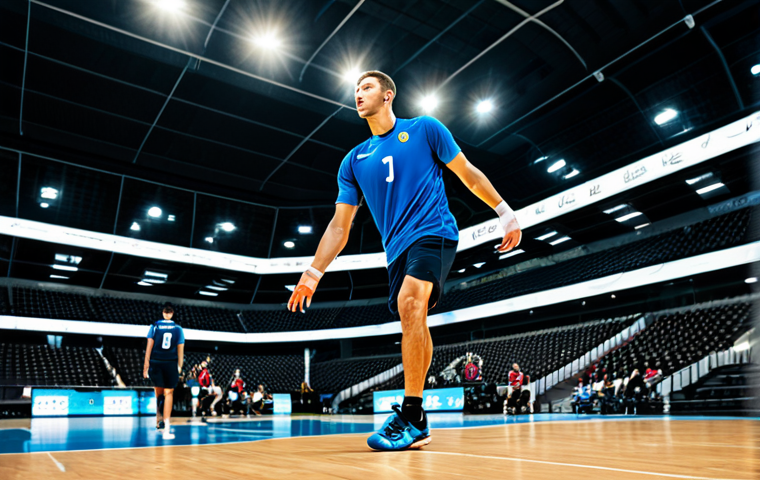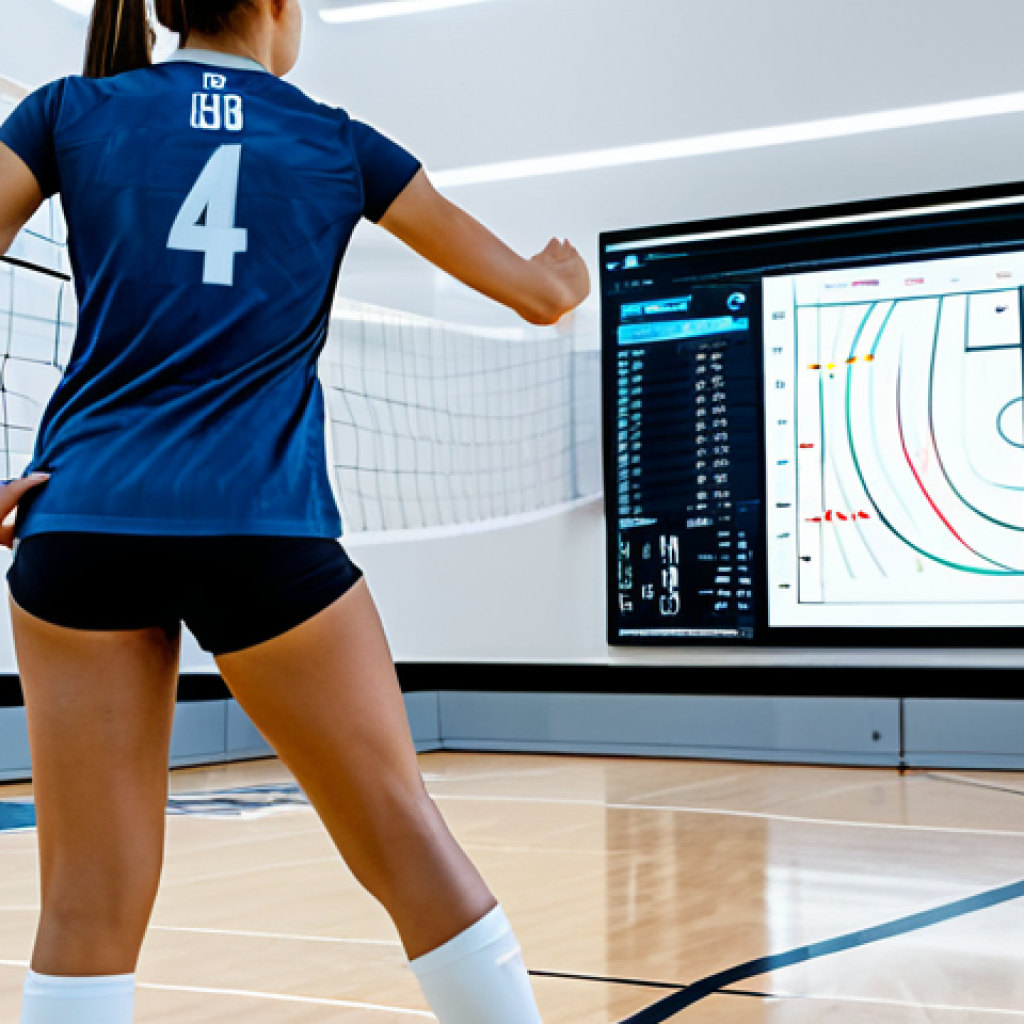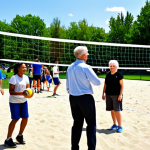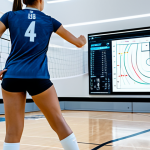Ever stepped onto the volleyball court, feeling like you’re putting in the effort, but not quite seeing the breakthroughs you crave? I’ve been there countless times – hitting the same serves, making similar digs, and wondering if I was truly improving or just going through the motions.
It’s frustrating to plateau when your passion is pushing you forward, right? The truth is, raw practice alone often isn’t enough to unlock your full potential.
You need a clearer picture of your strengths and, more importantly, your specific areas for growth. In today’s rapidly evolving sports landscape, where cutting-edge analytics, wearable tech, and even AI-driven insights are transforming how athletes train, the old ‘eye test’ just doesn’t cut it anymore.
We’re seeing a massive shift towards precise, data-backed methods that pinpoint exactly where you stand and what needs to change to take your game to the next level, optimizing everything from court movement to spike power.
Let’s dive deeper into it below.
Ever stepped onto the volleyball court, feeling like you’re putting in the effort, but not quite seeing the breakthroughs you crave? I’ve been there countless times – hitting the same serves, making similar digs, and wondering if I was truly improving or just going through the motions.
It’s frustrating to plateau when your passion is pushing you forward, right? The truth is, raw practice alone often isn’t enough to unlock your full potential.
You need a clearer picture of your strengths and, more importantly, your specific areas for growth. In today’s rapidly evolving sports landscape, where cutting-edge analytics, wearable tech, and even AI-driven insights are transforming how athletes train, the old ‘eye test’ just doesn’t cut it anymore.
We’re seeing a massive shift towards precise, data-backed methods that pinpoint exactly where you stand and what needs to change to take your game to the next level, optimizing everything from court movement to spike power.
Let’s dive deeper into it below.
Beyond the Eye Test: The Unseen Revolution in Volleyball Analytics

For years, coaching in volleyball often relied heavily on a seasoned coach’s keen eye, gut feeling, and perhaps some basic stat sheets compiled by hand. While invaluable, this traditional approach often missed the granular details that truly separate good players from great ones. I remember countless practices where a coach would tell me to “be quicker” or “hit harder,” and while I appreciated the feedback, it felt incredibly vague. How do you quantify “quicker”? What does “harder” truly mean in terms of measurable power? This is where the unseen revolution of advanced analytics steps in, providing concrete, objective data that can reveal patterns and inefficiencies invisible to the naked eye. It’s like switching from a blurry photograph to a high-definition video; suddenly, every nuance comes into focus, allowing for targeted improvements that were previously impossible to pinpoint. This shift isn’t just for elite professional teams; it’s becoming increasingly accessible for amateur and semi-pro players who are serious about their development.
1. The Evolution from Basic Stats to Deep Insights
Think about how far we’ve come from simply counting aces or hitting errors. Back when I started playing competitively, the most advanced stat we had was probably kill percentage. Now, we’re talking about sophisticated metrics like pass rating by zone, attack efficiency against specific block formations, and even jump height consistency over an entire match. I’ve personally experienced the frustration of thinking I was making great plays, only to see the data reveal that my “great plays” were actually inefficient, leading to more lost points than I realized. It’s a humbling, but ultimately empowering, realization. This deeper dive isn’t just about identifying problems; it’s about understanding the root causes and providing actionable solutions. For instance, instead of just seeing a low attack percentage, analytics can tell you if it’s due to poor set quality, late approach, or insufficient jump height against a specific blocker. This level of detail transforms coaching from prescriptive advice to precise, data-driven interventions.
2. Why Traditional Coaching Needs Data Augmentation
It’s not about replacing experienced coaches; it’s about equipping them with superpowers. I’ve seen some incredible coaches in my time who could spot a flaw just by instinct, but even the best human eye has limitations. Fatigue, subjective bias, and the sheer speed of the game make it impossible for anyone to process every single movement, every single decision point. Data provides an unbiased, unwavering record of performance. When I first started incorporating video analysis into my training, I was shocked to see how many subtle habits I had developed that I was completely unaware of – things like dropping my hitting arm too low on my approach or taking an extra step before my block. These tiny inefficiencies, when compounded over a match, lead to significant performance dips. Data, therefore, acts as a crucial complement, validating a coach’s insights while also revealing blind spots, fostering a more holistic and effective developmental pathway for players at all levels.
Decoding Your Movement: Precision Tracking and Biomechanics
One of the most eye-opening aspects of modern volleyball training for me has been the ability to precisely track movement. I used to think I moved pretty efficiently on the court, covering space and reacting quickly. Then I saw the heat maps and movement patterns generated by advanced tracking systems. It was like looking at a completely different game – my game, but seen through an objective lens that highlighted every wasted step, every inefficient angle. This goes beyond just how fast you run; it delves into the biomechanics of your movements: how much power you generate in your jump, the angles of your approach, the rotation of your torso during a spike. Understanding these intricate details is the difference between incremental gains and truly unlocking explosive potential. It’s no longer just about ‘being athletic’ but about being ‘athletically efficient,’ a concept that has personally transformed how I approach my on-court conditioning and technique drills.
1. The Mechanics of a Powerful Spike and Jump
Everyone wants a monster spike, right? And a sky-high jump. But how do you truly optimize them? For years, I focused on brute strength, thinking more gym time would automatically lead to more power. What I learned from biomechanical analysis was that it’s often about technique and sequencing rather than just raw muscle. We’re talking about the coordinated movement from your feet driving off the ground, through your hips, torso rotation, and finally, the whip of your arm. Analyzing my own spike, I discovered I was losing significant power by not engaging my core fully or by starting my arm swing too early. Technologies like motion capture and force plates can measure these elements with incredible precision, showing exactly where energy is being lost or where more can be generated. It’s a game-changer because it moves you beyond general advice to specific, measurable adjustments that directly impact your power output and jump height, reducing injury risk simultaneously.
2. Optimizing Court Coverage and Reaction Time
Volleyball is a game of relentless movement and split-second reactions. Are you really covering the court effectively, or are you just running a lot? This is where GPS trackers and advanced video analysis come into their own. They can show you not just where you are on the court, but how quickly you get there, your acceleration and deceleration patterns, and even your decision-making processes. I remember a drill where we tracked our defensive movements. I thought I was quick, but the data showed I was often taking an extra ‘recovery’ step after digging a ball, delaying my transition to offense. Or sometimes, I’d overcommit to one side, leaving a huge gap behind me. This kind of objective feedback, showing me my actual movement pathways and reaction times, forced me to confront my inefficiencies. It’s not just about speed; it’s about smart movement, anticipating where the ball will go, and getting there with the fewest, most effective steps. This is a crucial element for anyone aiming to be a truly dominant defensive or offensive player.
Leveraging Wearable Tech for Real-Time Performance Insights
The advent of wearable technology has been nothing short of revolutionary in sports, and volleyball is no exception. Gone are the days when performance analysis was confined to post-game video sessions or lab-based biomechanical assessments. Now, with a small device strapped to your wrist or clipped to your clothing, you can get real-time feedback on your performance during practice or even in a match. I’ve personally experimented with various wearables, from heart rate monitors that tell me if I’m pushing hard enough or recovering properly, to jump sensors that instantly tell me my vertical leap on every spike. This immediate data loop is incredibly empowering because it allows for instantaneous adjustments, transforming how you approach each drill and helping you manage your physical output throughout a strenuous training session or multi-set match. It’s like having a personal assistant constantly whispering performance metrics into your ear, guiding you toward optimal effort and technique.
1. Monitoring Physical Output and Preventing Overtraining
One of the biggest struggles I’ve faced as an athlete is finding that delicate balance between pushing hard enough to improve and overtraining to the point of exhaustion or injury. Wearable tech has been an absolute lifeline here. Devices that track heart rate variability, sleep patterns, and overall training load provide a comprehensive picture of your body’s recovery state. There were times I felt sluggish in practice, and instead of just pushing through, I’d check my data and realize my recovery metrics were off – perhaps I hadn’t slept well, or my last workout was more intense than I thought. This objective feedback allows me to adjust my effort level, choose recovery exercises, or even communicate more effectively with my coach about my physical state. It’s about listening to your body, but with data-backed confirmation. This proactive approach to training helps prevent burnout, reduces the risk of injuries like tendinitis or muscle strains, and ensures that every training session is productive and contributes positively to long-term development.
2. Instant Feedback on Technical Skills: Jumps, Serves, and Spikes
Imagine being able to see your jump height immediately after every single attempt, or getting feedback on your arm speed and spin on every serve. This isn’t science fiction; it’s current reality with specialized wearable sensors. I’ve used jump trackers that clip to my waist and instantly display my vertical leap, hang time, and even ground contact time. This immediate quantitative feedback is incredibly valuable. If a coach tells me to jump higher, and I make an adjustment, I can see the numerical difference right away. It makes the learning process incredibly efficient. Similarly, for serving, some sensors can measure racket or arm speed and even the spin on the ball. This allows for precision tuning of your technique. No more guessing if your float serve had enough pop or if your topspin serve had enough rotation; the numbers are right there, telling you exactly what’s happening, making practice sessions intensely focused and incredibly rewarding.
The Power of Video: Unmasking Technical Flaws and Strategic Gaps
If there’s one tool that has transformed my personal understanding of my own play, it’s video analysis. It’s one thing for a coach to tell you what you’re doing wrong; it’s an entirely different, and often humbling, experience to see it with your own eyes. I distinctly remember the first time I saw myself play on video. I thought I had a strong block, but the footage revealed that I was consistently crossing my hands too early or not penetrating enough over the net. It was a moment of stark realization, and the visual evidence made it impossible to deny. Video acts as an irrefutable mirror, reflecting every movement, every decision, and every nuance of your game. It unmasks those subtle technical flaws that become glaring errors under pressure and reveals strategic gaps that opponents exploit. The power of video goes beyond just identifying mistakes; it’s crucial for reviewing opponent tendencies and developing counter-strategies, making it an indispensable part of modern volleyball preparation.
1. Frame-by-Frame Breakdown: Pinpointing Micro-Inefficiencies
The beauty of video analysis lies in its ability to slow down the game to a frame-by-frame crawl. This allows you to identify micro-inefficiencies that fly by at full speed. For instance, my coach once pointed out that my left arm was dropping slightly during my hitting approach, causing a slight delay in my shoulder rotation. At full speed, I never noticed it, but in slow motion, it was clear as day. This seemingly tiny flaw was costing me precious milliseconds and impacting my hitting power. We then used the video to compare my form to professional players, dissecting every angle and movement to replicate their efficiency. This level of detail extends to every skill: passing platforms, setting hand positions, defensive angles, and even footwork patterns. It’s a meticulous process, but it’s where significant breakthroughs happen, as you eliminate those tiny, compounding errors that hold you back from peak performance. It’s a truly humbling yet incredibly effective way to refine your technique.
2. Scout Your Opponents: Anticipation and Strategic Advantage
Volleyball isn’t just about your own performance; it’s a strategic battle against an opponent. Video analysis is absolutely critical for scouting. Before a big match, my team and I would spend hours poring over footage of our opponents. We’d look for setter tendencies (do they favor the outside hitter on pass reception 1? What do they do on out-of-system plays?), hitter preferences (does the opposite always hit line from the right side?), and defensive alignments. I remember one match where we noticed the opposing middle blocker always shaded slightly early to block our outside hitter. Armed with this knowledge from video, we deliberately ran a quick set to our middle to exploit that opening, winning us a crucial point. This foresight, born from careful video review, provides an invaluable strategic advantage, allowing you to anticipate plays, set up your block and defense more effectively, and even choose your attack shots based on their defensive weaknesses. It’s like having a cheat sheet for the match before it even begins.
Crafting Your Custom Development Path: Data-Driven Drills
One of the most profound shifts I’ve experienced in my volleyball journey is moving away from generic drills to highly personalized, data-driven training. It used to be that everyone did the same drills, regardless of their specific weaknesses. While group drills are important for team cohesion, true individual improvement demands a tailored approach. If the data from my performance analysis shows I struggle with digging cross-court shots, then my training plan needs to heavily feature drills that expose me to and help me master that specific skill. This isn’t just about identifying what you’re bad at; it’s about understanding *why* you’re struggling and then designing interventions that directly address the root cause. This level of customization transforms practice from a general workout into a precision-engineered development pathway, maximizing every minute you spend on the court and ensuring that you’re always working on what truly matters for your individual growth. It feels incredibly empowering to know that your training is designed specifically for you, targeting your unique needs and accelerating your progress.
1. From Weakness Identification to Targeted Drill Design
The beauty of comprehensive data analysis is that it doesn’t just give you a broad overview; it drills down into granular detail, pinpointing your exact weaknesses. For example, my hitting stats once revealed I had a significantly lower kill percentage when hitting from the left side against a double block compared to a single block. This immediately highlighted a specific area for improvement. Instead of just doing general hitting drills, my coach and I designed targeted sessions where I would specifically practice hitting against a double block from the left side, focusing on tooling the block or hitting sharp angles. We even used a blocking machine set up to mimic real-game scenarios. This precision in identifying and then addressing weaknesses makes training far more effective and less frustrating. It’s like having a personal prescription for your athletic development, ensuring that every drop of sweat contributes directly to overcoming your most significant hurdles. This strategic approach ensures no time is wasted and every effort counts.
2. Progressive Overload and Skill Refinement Through Data
Just like in strength training, skill development benefits immensely from progressive overload, but it needs to be smart, not just harder. Data allows you to systematically increase the difficulty or complexity of a drill as your skills improve. If my passing accuracy in zone 5 improves from 70% to 85% based on data, then it’s time to introduce more challenging scenarios – faster serves, more unpredictable trajectories, or higher pressure situations. Similarly, for a setter, once their tempo to the outside hitter is consistently precise, the next step might be to integrate complex combinations or quick sets under duress. This isn’t about guesswork; it’s about making data-informed decisions on when to push harder, when to focus on refinement, and when to introduce new challenges. It ensures you’re always operating at the edge of your capabilities without becoming overwhelmed, creating a continuous cycle of improvement where each achieved milestone sets the stage for the next. This constant, data-guided push is what truly separates ambitious players.
The Mental Game: Building Resilience Through Awareness and Analysis
While physical prowess and technical skill are undeniably crucial, I’ve learned that the mental game in volleyball is often the true differentiator. How many times have you seen a technically brilliant player crumble under pressure, or a less skilled team win simply because they had unwavering focus and resilience? I’ve certainly been on both sides of that coin. The shift to data-driven analysis isn’t just about your physical actions; it’s increasingly about understanding your mental state and how it impacts performance. This includes everything from emotional regulation during high-stakes points to maintaining focus throughout a long match. Incorporating mental skills training, often informed by performance data, has become a cornerstone of my own development. It’s about building a robust mental fortress that allows you to perform consistently, even when the pressure is immense. It’s learning to acknowledge the nerves, process errors constructively, and maintain a competitive composure that radiates confidence on the court, a skill that often goes unnoticed but is felt acutely by everyone.
1. Performance Under Pressure: Analyzing Clutch Moments
Ever wondered why you ace a serve in practice but double-fault at match point? Data can help shed light on these “clutch” moments. By analyzing performance metrics specifically during high-pressure situations – late in sets, tie-breakers, or when serving for the match – you can identify patterns. Do your hitting errors spike when the score is tight? Does your passing accuracy drop significantly after a long rally? I once noticed from my stats that my serve receive accuracy dipped dramatically when we were down by more than three points in a set. This wasn’t about my physical ability; it was about the mental pressure affecting my technique. Knowing this allowed me to work with a sports psychologist on specific visualization techniques and breathing exercises to maintain composure during those critical moments. It’s about turning insights from data into actionable strategies for mental resilience, training your mind just as rigorously as you train your body to ensure you perform when it matters most. It’s about mastering your own reactions and harnessing them for success.
2. Focus, Fatigue, and Emotional Regulation Tracking
Maintaining peak focus throughout a grueling five-set match is incredibly challenging. How do you know when mental fatigue is setting in, or when emotions are getting the better of you? While not as directly measurable as a spike, there are emerging ways to track and analyze these aspects. Heart rate monitors can show spikes in stress levels, and coaches can use specific performance metrics (like increased unforced errors or decreased communication) as indicators of mental fatigue. I’ve found simple self-reflection logs incredibly useful, where I note how I felt emotionally during different phases of a match, especially after errors or big points. Over time, I’ve seen patterns emerge that link certain emotional states to specific performance drops. Understanding these links allows you to develop personalized coping mechanisms – whether it’s a quick mental reset routine, a specific breathing exercise, or simply stepping back for a moment. This proactive approach to managing your internal state is critical for sustained high-level performance and for demonstrating true leadership on the court.
Integrating Smart Training: From Data Points to Dominant Play
The true magic of modern volleyball training isn’t just in collecting data; it’s in intelligently integrating those data points into a cohesive, actionable training strategy that transforms you into a dominant player. It’s a holistic approach, moving beyond isolated drills to a comprehensive system where every aspect of your development – physical, technical, tactical, and mental – is informed by objective insights. I remember feeling overwhelmed when I first started seeing all the numbers and charts. It was exciting, but also a lot to process. The key, I quickly learned, was to work closely with my coaches and trainers to translate those raw numbers into meaningful, personalized action plans. This integration is where the abstract concept of ‘data’ becomes the tangible reality of improved serves, higher jumps, quicker digs, and, ultimately, more wins. It’s about creating a synergistic training environment where technology and human expertise combine to unlock your absolute best self on the court, pushing the boundaries of what you thought was possible.
1. Building a Comprehensive Player Profile
Imagine having a detailed, evolving profile of yourself as a volleyball player that captures every measurable aspect of your game. This is what modern data integration allows. It combines everything from your biomechanical efficiency on a spike to your passing consistency in various zones, your reaction time, your physical fatigue levels, and even your performance under pressure. This comprehensive profile is a living document, constantly updated with new practice and game data. For me, seeing my profile evolve over a season – watching my jump height increase, my hitting efficiency improve against specific blocks, or my serve receive accuracy become more consistent – provided immense motivation and a clear roadmap for continued improvement. It allows coaches to make informed decisions about your position, rotation, and specific roles within the team, truly playing to your strengths while actively shoring up your weaknesses. This is where you move from being just a player to becoming a strategically optimized athlete.
| Aspect of Play | Traditional Assessment | Data-Driven Assessment |
|---|---|---|
| Spiking Power | “Hits hard,” “Good arm swing” | Exit velocity (mph), Jump height (inches), Arm swing speed (rad/s), Torso rotation (degrees) |
| Passing Accuracy | “Good passer,” “Shanks sometimes” | Pass rating (0-3 scale) by zone, Serve type, Passer movement distance, First ball contact point |
| Court Coverage | “Moves well,” “A bit slow” | Heat maps, Distance covered (meters), Sprint velocity, Change of direction speed, Number of explosive efforts |
| Blocking Effectiveness | “Gets good blocks,” “Jumps early” | Block touch percentage, Penetration depth, Hand positioning, Opponent hitting angle, Jump timing synchronization |
2. The Continuous Feedback Loop: Adapt, Analyze, Improve
The beauty of integrated smart training is the establishment of a continuous feedback loop. It’s not a one-time analysis; it’s an ongoing process. You train, data is collected, that data is analyzed, insights are generated, adjustments are made to your training, and then you train again, completing the loop. This iterative process is incredibly powerful. I’ve found myself constantly reviewing video and data after practices and games, not just to see my mistakes, but to understand if the adjustments I made based on previous data actually worked. Did that new approach angle improve my hitting efficiency? Did those specific defensive drills make my reaction time quicker? This constant questioning and objective validation ensure that your training remains dynamic and responsive to your actual performance. It allows for rapid adaptation, accelerating your learning curve and ensuring that your development never stagnates. This relentless pursuit of optimization, driven by objective data and refined through experience, is the ultimate pathway to becoming a truly dominant force on the volleyball court.
Closing Thoughts
The journey from relying solely on the ‘eye test’ to embracing data-driven insights has been a revelation for me, fundamentally changing how I approach volleyball.
What once felt like guesswork in training now feels like a precise, scientific endeavor. It’s about empowering yourself with objective truth, allowing you to see beyond surface-level performance and truly understand the intricacies of your game.
This isn’t just about becoming a better player; it’s about becoming a smarter, more resilient, and ultimately, a more confident athlete. So, whether you’re an aspiring pro or a passionate amateur, embrace this revolution – your future self on the court will thank you for it.
Useful Information to Know
1. Start Simple: You don’t need a million-dollar setup from day one. A good smartphone for video analysis, combined with a basic heart rate monitor, can provide immense value and are excellent starting points for integrating data into your training.
2. Find a Data-Friendly Coach: The technology is only as good as the interpretation. Working with a coach who understands how to translate raw data into actionable drills and personalized feedback is invaluable for maximizing your progress.
3. Analyze, Don’t Just Collect: Raw data itself means nothing without understanding what it’s telling you. Dedicate time to review your metrics and video footage regularly, looking for patterns and specific areas for improvement rather than just accumulating numbers.
4. Prioritize Injury Prevention: Data on workload, recovery metrics, and biomechanics can significantly reduce your risk of common volleyball injuries. Use these insights to manage your training volume and ensure adequate rest and recovery.
5. Integrate Mental Training: Performance analytics often expose mental fatigue or pressure issues during critical moments. Use these insights to proactively develop mental resilience strategies, like visualization or breathing techniques, to maintain composure.
Key Takeaways
Modern volleyball training transcends traditional methods, leveraging advanced analytics, wearable tech, and video analysis for unparalleled precision.
Data provides objective insights into technical flaws, movement patterns, and physical output, revealing areas invisible to the naked eye. Integrating these insights allows for custom, targeted training plans that address individual weaknesses and optimize performance.
The continuous feedback loop of data collection, analysis, and adaptation accelerates learning and fosters sustained improvement. Beyond physical skills, data aids in understanding and enhancing the mental game, building resilience under pressure and ultimately transforming players into dominant forces on the court.
Frequently Asked Questions (FAQ) 📖
Q: I totally get that frustration of putting in the work but feeling stuck. What exactly makes traditional practice fall short, and how can I really tell if I’m just spinning my wheels instead of genuinely getting better?
A: Oh, tell me about it! I’ve been there so many times, hitting countless serves, practicing the same drills, and just feeling… stagnant. The thing is, our traditional “eye test” – whether it’s your coach watching you, or you just feeling like you’re improving – has its limits.
It’s inherently subjective, right? You might think you’re hitting harder, but without objective data, how do you really know if your spike velocity actually increased from 40 mph to 45 mph, or if your court coverage improved by a crucial extra foot?
That’s the real trap: we rely on our gut, but our gut often misses the minute, critical details. You know you’re plateauing when you keep making the same mistakes under pressure, or your progress charts – if you even have them – flatline.
It’s like trying to navigate a dense fog without GPS; you’re moving, but you don’t really know where you are or if you’re going in the right direction.
Data cuts through that fog, showing you precisely where you are and, more importantly, why.
Q: So, if the “eye test” is out, what specific “cutting-edge analytics” and “
A: I-driven insights” are we actually talking about here? It sounds a bit like science fiction. A2: It might sound like science fiction, but trust me, it’s very real and increasingly accessible!
We’re talking about everything from tiny, unobtrusive wearable sensors – think a small device clipped to your shoe or jersey – that track your movement, acceleration, and even your jumping height with incredible precision.
Then there’s advanced video analysis software that, powered by AI, can automatically break down your technique frame by frame: analyzing your swing path for a perfect serve, spotting inefficiencies in your footwork, or even measuring the angle of your jump for optimal block timing.
It’s not just about collecting raw numbers; it’s about sophisticated algorithms that can identify patterns you’d never see with the naked eye. For instance, it can tell you if your fatigue levels start dropping your serve percentage after the second set, or if you consistently land on one leg harder than the other, pointing to a potential injury risk.
It turns qualitative observations into concrete, actionable data points.
Q: Is all this high-tech training really necessary for someone like me, who’s passionate but not a professional athlete? Or is it just overkill and a big expense for the average person trying to improve their weekend game?
A: That’s a super valid question, and one I hear all the time! For years, this kind of tech was definitely reserved for the pros – the elite teams with massive budgets.
But here’s the game-changer: the technology has become much more affordable and user-friendly. You don’t need a million-dollar lab to get valuable insights anymore.
Think about it: a decent wearable sensor might cost you less than a pair of high-end athletic shoes, and the insights it provides can prevent injuries that would sideline you for months or shave weeks off your improvement curve.
For a passionate amateur, it’s not about becoming a pro overnight, it’s about getting smarter with your training. Why spend hours on inefficient practice when you can get precise feedback that accelerates your progress significantly?
It’s not overkill if you value your time, your health, and the sheer joy of seeing tangible improvements in your game. It’s an investment in getting the most out of your passion, plain and simple.
📚 References
Wikipedia Encyclopedia
구글 검색 결과
구글 검색 결과
구글 검색 결과
구글 검색 결과
구글 검색 결과





